Themed collection 2023 Journal of Materials Chemistry A HOT Papers

Microporous metal–organic frameworks for the purification of propylene
The latest advancement in developing MOF adsorbents for effective separation and purification of propylene from propane is summarized, with a focus on molecular exclusion based separation mechanism and propane-selective adsorption.
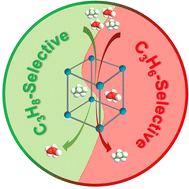
J. Mater. Chem. A, 2023,11, 12425-12433
https://doi.org/10.1039/D2TA09326J
Atomic metal coordinated to nitrogen-doped carbon electrocatalysts for proton exchange membrane fuel cells: a perspective on progress, pitfalls and prospectives
This Perspective highlights past achievements, knowledge gaps and future research directions for M-N-C catalysts for PEMFCs.

J. Mater. Chem. A, 2023,11, 23211-23222
https://doi.org/10.1039/D3TA04711C
Advanced engineering strategies for Li2S cathodes in lithium–sulfur batteries
This review comprehensively explores the diverse strategies of Li2S engineering and examines potential avenues for enhancing structural stability and electrochemical performance.
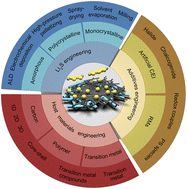
J. Mater. Chem. A, 2023,11, 26318-26339
https://doi.org/10.1039/D3TA06057H
The metal–support interaction effect in the carbon-free PEMFC cathode catalysts
The metal–support interaction effect in the carbon-free PEMFCs cathode catalysts are summarized in this review.
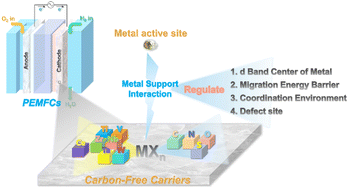
J. Mater. Chem. A, 2023,11, 23106-23132
https://doi.org/10.1039/D3TA04792J
Uranium and lithium extraction from seawater: challenges and opportunities for a sustainable energy future
Our analysis of the current literature shows that advances in extractive technologies for U/Li recovery lie at the intersection between molecular simulation, nanotechnology and materials science, electrochemistry, and membrane engineering.
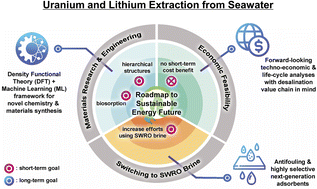
J. Mater. Chem. A, 2023,11, 22551-22589
https://doi.org/10.1039/D3TA05099H
Recent progress in anion exchange membranes (AEMs) in water electrolysis: synthesis, physio-chemical analysis, properties, and applications
An overview of recent advancements in anion exchange membranes (AEMs) and their performance in water electrolysis is provided, and the progress of an electrocatalyst for anion exchange membrane water electrolysis (AEMWE) is also discussed.

J. Mater. Chem. A, 2023,11, 20886-21008
https://doi.org/10.1039/D3TA04298G
Advanced progress of rhenium (Re)-based electrode materials in electrocatalytic hydrogen evolution: a review
Rhenium (Re)-based materials are regarded as ideal alternative electrocatalysts towards the HER. This review focused on summarizing the advanced HER progress, aiming to establish a theoretical and experimental basis for constructing optimal Re-based electrocatalysts.

J. Mater. Chem. A, 2023,11, 14451-14468
https://doi.org/10.1039/D3TA02004E
Multifunctional small biomolecules as key building blocks in the development of hydrogel-based strain sensors
Multifunctional small biomolecules enhance the multifunctionality and performance of hydrogel-based strain sensors.

J. Mater. Chem. A, 2023,11, 13844-13875
https://doi.org/10.1039/D3TA01627G
Covalent organic framework and hydrogen-bonded organic framework for solar-driven photocatalysis
The features of COF and HOF in porosity, light harvesting, and structural multifunctionality enable their application for photocatalysis. Focusing on the existing merits, rational developing way is helpful for constructing more excellent porous photocatalyst.
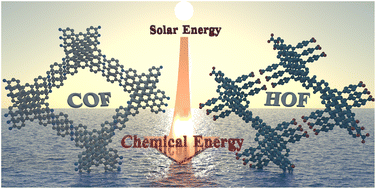
J. Mater. Chem. A, 2023,11, 12521-12538
https://doi.org/10.1039/D2TA09375H
Solar driven CO2 reduction: from materials to devices
Solar driven CO2 reduction is a promising technology for achieving carbon neutrality. The optimized photo-absorber, catalyst and device and their synergistic operation are essential for realizing a highly efficient solar driven CO2 reduction system.

J. Mater. Chem. A, 2023,11, 12499-12520
https://doi.org/10.1039/D3TA00267E
Halide perovskite quantum dots for photocatalytic CO2 reduction
This review focuses on halide perovskite quantum dots (QDs) for photocatalytic CO2 reduction, discussing the structures and properties of perovskite QDs, the mechanism for CO2 reduction, photocatalyst design, challenges and directions for future research.

J. Mater. Chem. A, 2023,11, 12482-12498
https://doi.org/10.1039/D2TA09521A
Advances in harvesting water and energy from ubiquitous atmospheric moisture
Sorbent-assisted AWH and moisture-enabled energy generation are reviewed in parallel to reveal the correlation between these two technologies.

J. Mater. Chem. A, 2023,11, 12456-12481
https://doi.org/10.1039/D2TA09552A
Turning trash into treasure: recent advances in triboelectric nanogenerator based on waste-derived carbonized materials
This paper reviews the features and preparation methods of waste-derived carbonized materials (WDCM), the working mechanism of the WDCM-based triboelectric nanogenerator (TENG), and the application and prospects of WDCM-based TENG in various fields.

J. Mater. Chem. A, 2023,11, 9194-9215
https://doi.org/10.1039/D3TA01132A
Recent progress in phosphide materials for thermoelectric conversion
Metal phosphides combine elemental abundance, structural and bonding diversity, and are promising thermoelectric materials.

J. Mater. Chem. A, 2023,11, 8453-8469
https://doi.org/10.1039/D3TA00620D
Recent progress and perspectives on cation disordered rock-salt material for advanced Li-ion batteries
Over the past decades, the utilization of Li-ion batteries has provided the benefits of high energy and power density and can be used in a variety of applications, including electric vehicles, large-scale energy storage, and the power grid.

J. Mater. Chem. A, 2023,11, 8426-8452
https://doi.org/10.1039/D3TA00852E
Micro- and nano-structural design strategies towards polycrystalline nickel-rich layered cathode materials
The development of micro- & nano-structure engineering in recent years is reviewed. The synthesis methods and mechanisms of different microstructures are summarized, and the future development direction of microstructure modification is proposed.

J. Mater. Chem. A, 2023,11, 7867-7897
https://doi.org/10.1039/D3TA00320E
Research progress on the construction of synergistic electrocatalytic ORR/OER self-supporting cathodes for zinc–air batteries
The synthetic strategies, application and future development of non-precious metal-based self-supporting electrodes for Zn–air batteries have been systematically summarized according to the recent research progress.

J. Mater. Chem. A, 2023,11, 4400-4427
https://doi.org/10.1039/D2TA09626A
Metallic active-site engineering: a bridge between covalent triazine frameworks and high-performance catalysts
Engineering metallic active sites (nano-scale/low-coordination/isolated metal active sites and active metal oxide/sulfide) into CTFs is an effective strategy for high-performance and large-scale industrial catalysis.
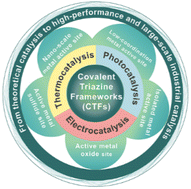
J. Mater. Chem. A, 2023,11, 2070-2091
https://doi.org/10.1039/D2TA08840A
Thermocatalytic CO2 conversion by siliceous matter: a review
Silica/silicate-based nanocatalysts have shown great potential for catalytic hydrogenation of CO2 to various value-added chemicals. This review presents the recent development of siliceous matter in this important field of heterogeneous catalysis.
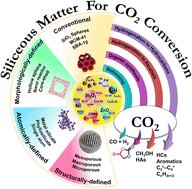
J. Mater. Chem. A, 2023,11, 1593-1633
https://doi.org/10.1039/D2TA07613F
Realization of electron-deficient Ru sites via Co4N coupling for synergistically enhanced alkaline hydrogen evolution
The effective charge transfer from Ru to Co4N allows an optimized water adsorption energy and more electrons to activate H2O molecules, thus realizing an enhanced activity for hydrogen evolution.

J. Mater. Chem. A, 2023,11, 22147-22153
https://doi.org/10.1039/D3TA04769E
Multicore–shell iron fluoride@carbon microspheres as a long-life cathode for high-energy lithium batteries
Multicore–shell iron fluoride@carbon microspheres, synthesized using a bottom-up method, have a quality carbon coat and smaller core size. As a conversion cathode of lithium batteries, it exhibits notable stability over 3500 cycles at 1 C.

J. Mater. Chem. A, 2023,11, 21541-21552
https://doi.org/10.1039/D3TA05054H
Multifunctional materials for catalyst-specific heating and thermometry in tandem catalysis
A multifunctional material design, integrating catalytic and auxiliary magnetic susception and contactless thermal sensing functionalities, unlocks catalyst-specific heating and thermometry for spatially proximate solid catalysts in a single reactor.

J. Mater. Chem. A, 2023,11, 19854-19859
https://doi.org/10.1039/D3TA03654E
Negative-pressure sulfurization of antimony sulfide thin films for generating a record open-circuit voltage of 805 mV in solar cell applications
Herein, we developed a new sulfurization method to obtain S-rich Sb2S3, which passivated the internal deep-level defects of the film. Finally, a record open-circuit voltage of 805 mV was achieved, which is the highest value for Sb2S3 solar cells.

J. Mater. Chem. A, 2023,11, 19298-19307
https://doi.org/10.1039/D3TA04604D
Tuning the guest-induced spatiotemporal response of isostructural dynamic frameworks towards efficient gas separation and storage
One-atom exchange in a flexible MOF changes the 2nd order phase transformation to 1st order, enabling efficient gas storage and separation.

J. Mater. Chem. A, 2023,11, 18646-18650
https://doi.org/10.1039/D3TA02167J
Metal–metalloid alloys: mesoporous Rh–Te films for electrocatalytic nitrogen fixation
Mesoporous Rh–Te alloy films on carbon paper are synthesized via a micelle-assisted electrodeposition method, exhibiting improved performance for nitrogen reduction to ammonia.

J. Mater. Chem. A, 2023,11, 17479-17483
https://doi.org/10.1039/D3TA03548D
InCl3-modified SnO2 as an electron transporting layer for Cd-free antimony selenide solar cells
We demonstrated InCl3 modified SnO2 as ETL in Sb2Se3 solar cells. InCl3 post-treatment blocked the downward diffusion of Se and improved the quality of the SnO2/Sb2Se3 heterojunction. Thus, a Cd-free Sb2Se3 solar cell achieved a PCE of 5.52%.

J. Mater. Chem. A, 2023,11, 16963-16972
https://doi.org/10.1039/D3TA03358A
Effect of singlet oxygen on redox mediators in lithium–oxygen batteries
1O2 reacts with RMs but the effect of 1O2 on the function of RMs has been ambiguous. In this work we show the effect of RMs functionality from various perspectives and classified them following the reaction of RMs with 1O2.

J. Mater. Chem. A, 2023,11, 16003-16008
https://doi.org/10.1039/D3TA01284K
Self-templated synthesis of novel and robust honeycomb-like N-doped highly graphitized carbon from low-temperature carbonization
Honeycomb-like N-doped highly graphitized carbon is prepared by self-templated magnesiothermic reduction. Porosity and graphiticity of the prepared carbon support greatly improve the catalytic performance and durability of PtCo alloy in PEMFCs.

J. Mater. Chem. A, 2023,11, 13916-13922
https://doi.org/10.1039/D3TA02127K
Advancing vapor-deposited perovskite solar cells via machine learning
The optimal device architecture and its fabrication parameters for vapor-deposited perovskite solar cells are investigated by machine learning, predicting the highest power conversion efficiency of 26.1%.

J. Mater. Chem. A, 2023,11, 13201-13208
https://doi.org/10.1039/D3TA00027C
High-areal-capacity anode-free all-solid-state lithium batteries enabled by interconnected carbon-reinforced ionic-electronic composites
A three-dimensional carbon-reinforced ionic-electronic composite (CRIEC) boosts the cycling areal capacities of working anode-free all-solid-state lithium batteries.

J. Mater. Chem. A, 2023,11, 12713-12718
https://doi.org/10.1039/D3TA00121K
Enhancing the cycle-life of initial-anode-free lithium-metal batteries by pre-lithiation in Mn-based Li-rich spinel cathodes
Benefiting from the highly reversible structural evolution of the pre-lithiated Li-rich Li2Mn2O4 cathode, the corresponding anode-free coin cell delivers a considerable 94.4% capacity retention after 40 cycles.

J. Mater. Chem. A, 2023,11, 11119-11125
https://doi.org/10.1039/D3TA01823G
How carbon contamination on the photocatalysts interferes with the performance analysis of CO2 reduction
Carbon contamination on the photocatalysts intereferes the performance analysis of photocatalytic carbon dioxide (CO2) reduction reaction (CO2RR).

J. Mater. Chem. A, 2023,11, 10149-10154
https://doi.org/10.1039/D3TA00834G
Understanding and unlocking the role of V in boosting the reversible hydrogen storage performance of MgH2
The strong bonding interactions between V and H lead to the decrease of the energy required for H2 desorption from MgH2 to 49.5 kJ mol−1, 10.9 kJ mol−1 lower than that of pristine MgH2.

J. Mater. Chem. A, 2023,11, 9762-9771
https://doi.org/10.1039/D3TA01029E
Fluoroalkyl phosphonic acid radical scavengers for proton exchange membrane fuel cells
Fluoroalkyl phosphonic acids are demonstrated to be an efficient radical scavenger for Nafion™, showing a 58% lower fluoride emission rate than the state of the art, cerium.

J. Mater. Chem. A, 2023,11, 9748-9754
https://doi.org/10.1039/D2TA09421E
Ultrahigh energy storage density, high efficiency and superior thermal stability in Bi0.5Na0.5TiO3-based relaxor ferroelectric ceramics via constructing multiphase structures
BNT-based ceramics with polymorphic PNRs display an ultrahigh Wrec of 7.4 J cm−3 and a high η of 89% at 400 kV cm−1, as well as excellent thermal reliability.

J. Mater. Chem. A, 2023,11, 7987-7994
https://doi.org/10.1039/D3TA00068K
(Bi1/6Na1/6Ba1/6Sr1/6Ca1/6Pb1/6)TiO3-based high-entropy dielectric ceramics with ultrahigh recoverable energy density and high energy storage efficiency
The unique atom configuration in high-entropy dielectric ceramics gives rise to high Pmax, small Pr. Accordingly, ultrahigh recoverable energy density of 8.8 J cm−3 and high η of 92.5%, as well as excellent thermal stability, are achieved.

J. Mater. Chem. A, 2023,11, 4937-4945
https://doi.org/10.1039/D2TA10098C
Dynamic molecular tunnel junctions based on self-assembled monolayers for high tunneling current triboelectricity generation
Here, we show a novel energy conversion design with a dynamic MIM structure. This is realized though grafting CF3 group which shows high tunnelling current density of up to 7.6 × 106 Am−2. This can further fulfill the macroscopic energy harvesting.

J. Mater. Chem. A, 2023,11, 4946-4956
https://doi.org/10.1039/D2TA10048G
Photostable organic solar cells based on non-fullerene acceptors with an aminated bathocuproine electron transport layer
Solution-processed bathocuproine (BCP) has been widely used in fullerene (FA)-based organic solar cells (OSCs) for decades as an electron transport layer (ETL).

J. Mater. Chem. A, 2023,11, 4510-4518
https://doi.org/10.1039/D2TA09327H
Inhibition of the P3–O3 phase transition via local symmetry tuning in P3-type layered cathodes for ultra-stable sodium storage
We reconfigure the sodiation/desodiation process of P3-type layered cathodes by a local symmetry tuning strategy to enhance their stability. The cathodes exhibit long-term cycling stability with a higher capacity retention of 74% after 2000 cycles at 1C.

J. Mater. Chem. A, 2023,11, 2618-2626
https://doi.org/10.1039/D2TA09277H
Super-efficient fire safety poly(lactide) enabled by unique radical trapping
Poly(lactic acid) (PLA) as a promising bio-plastic will decompose to small molecule flammable volatiles via chain scission, which thus exhibit poor fire safety and highly restrict its real-world applications.
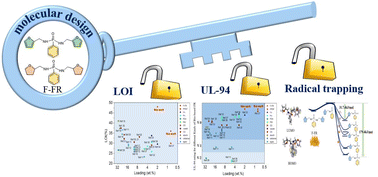
J. Mater. Chem. A, 2023,11, 1651-1657
https://doi.org/10.1039/D2TA08102D
Redox mediators promote electrochemical oxidation of nitric oxide toward ambient nitrate synthesis
Under ambient conditions, using low concentration NO (1%), ultrahigh nitrate formation rates in a two-electrode system can be achieved via the eCOR-NOOR. The structure changes of electrode materials under real reaction conditions are revealed.

J. Mater. Chem. A, 2023,11, 1098-1107
https://doi.org/10.1039/D2TA08823A
Origin of electric field-dependent charge generation in organic photovoltaics with planar and bulk heterojunctions
The electric field dependence in the charge generation process of organic solar cells in planar heterojunction and bulk heterojunction structures is related to the energetics and molecular orientation at the donor/acceptor interfaces.

J. Mater. Chem. A, 2023,11, 26499-26507
https://doi.org/10.1039/D3TA06835H
Band gap engineering by cationic substitution in Sn(Zr1−xTix)Se3 alloy for bottom sub-cell application in solar cells
The bandgap of SnZrSe3 was successfully engineered by cationic substitution to create novel materials photoactive in the short wavelength infrared region.

J. Mater. Chem. A, 2023,11, 26488-26498
https://doi.org/10.1039/D3TA05550G
Dy(OH)3: a paramagnetic magnetocaloric material for hydrogen liquefaction
Dy(OH)3 has impressive magnetocaloric performance optimised around 20 K making it suitable for hydrogen liquefaction using magnetic cooling.

J. Mater. Chem. A, 2023,11, 26474-26480
https://doi.org/10.1039/D3TA05358J
Copper hydroxide/basic copper salt derived Cu0 with a clear grain boundary for selective electrocatalytic CO2 reduction to produce multicarbon products
Cu(OH)2/basic copper salt compounds are in situ reduced to Cu0 nanoparticles with clear grain boundaries during the electrocatalytic CO2 reduction process, which endows the derived Cu electrocatalyst with high selectivity towards C2+ products.

J. Mater. Chem. A, 2023,11, 26481-26487
https://doi.org/10.1039/D3TA05628G
Mechanistic insight into a Co-based metal–organic framework as an efficient oxygen electrocatalyst via an in situ FT-IR study
Cobalt-imidazole-tetracarboxylate metal–organic framework (Co-MOF) and further modified with graphene (G) as heterogeneous electrocatalyst displays a bifunctional electrocatalytic performance towards ORR/OER.

J. Mater. Chem. A, 2023,11, 26508-26518
https://doi.org/10.1039/D3TA05711A
First-principles study on the photocatalytic field of two-dimensional Janus BiSY (Y = I, Br, Cl) monolayers
This study demonstrates the photocatalytic performance of two-dimensional Janus BiSY (Y = I, Br, Cl) based on energy bands, vacuum energy levels, absorption spectra, and reaction potential diagrams.

J. Mater. Chem. A, 2023,11, 26442-26451
https://doi.org/10.1039/D3TA06337B
In situ molecule-level interface tailoring of metastable intermolecular composite chips toward on-demand heat release and information encryption
A promising high-energy nano-Al/MnO2 MIC chip with on-demand heat-release and in situ information recording/encryption was designed, which provides a novel insight for the development of the next generation of smart MIC devices.

J. Mater. Chem. A, 2023,11, 26465-26473
https://doi.org/10.1039/D3TA04408D
Underlying factors of mega pressure hysteresis in cerium-rich CaCu5-type metal hydrides and effective modification strategies
Strong elastic deformation resistance and an intrinsic stable energetic state contribute to the mega pressure hysteresis in Ce-rich CaCu5-type metal hydrides.

J. Mater. Chem. A, 2023,11, 25963-25972
https://doi.org/10.1039/D3TA06351H
Morphology and cell performance of poly(fluorene)-based anion exchange membranes for water electrolysis: effect of backbone core structure
We report on the different core structures comprising biphenyl, fluorene, and spirobifluorene-based poly(fluorene) with an alkyl incorporated into the polymer backbone to confirmed the effect of core structures on morphology and ionic conductivity.

J. Mater. Chem. A, 2023,11, 25938-25944
https://doi.org/10.1039/D3TA05669D
A highly durable AgOx cluster/mesoporous TiO2 photocatalyst with synergistic effects induced superior H2 evolution and CO2 reduction
Obtained from in situ surface anchoring, the highly active and durable AgOx cluster@mesoporous TiO2 exhibits tunable physicochemical property that facilitates superior photocatalytic HER and CO2RR, and changes selective production from CO/CH4 to CO.

J. Mater. Chem. A, 2023,11, 25910-25917
https://doi.org/10.1039/D3TA04526A
High piezoelectricity induced by lattice distortion and domain realignment in Li2CO3-added lead-based ceramics
The 0.2Pb(Ni1/3Nb2/3)O3–0.1Pb(Zn1/3Nb2/3)O3–0.7Pb(Zr0.46Ti0.54)O3 + xwt% Li2CO3 ceramics were synthesized by the solid–state reaction method.

J. Mater. Chem. A, 2023,11, 25945-25954
https://doi.org/10.1039/D3TA05899A
Ultrafast 3MLCT quenching and vibrational coherence: excited-state dynamics of the first-discovered Fe(II)–carbene sensitiser resolved
Full-dimensional trajectory surface hopping dynamics simulations reveal the intricate details of the photorelaxation mechanism in [Fe(bmip)2]2+, the first-discovered Fe–carbene photosensitiser (bmip = 2,6-bis(3-methyl-imidazole-1-ylidine)-pyridine).

J. Mater. Chem. A, 2023,11, 25955-25962
https://doi.org/10.1039/D3TA05985E
Realizing low-ion-migration and highly sensitive X-ray detection by building g-C3N4 and CH3NH3PbI3 bulk heterojunction pellets
A g-C3N4 and CH3NH3PbI3 bulk heterojunction pellet can achieve high X-ray sensitivities with a small dark current drift. It also showed long-term current stability under operational conditions, indicating its application in sensitive X-ray imaging.
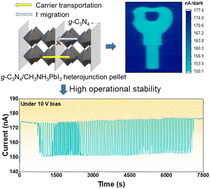
J. Mater. Chem. A, 2023,11, 25918-25928
https://doi.org/10.1039/D3TA05555H
Identifying pathways to metal–organic framework collapse during solvent activation with molecular simulations
Visualisation of MOF activation mechanisms, showing gas-like solvent behaviour leading to successful activation (top), and capillary-like solvent behaviour leading to collapse (bottom).

J. Mater. Chem. A, 2023,11, 25929-25937
https://doi.org/10.1039/D3TA04647H
Hollow sp2-conjugated covalent organic framework encapsulating thiophene-based photosensitizer for enhanced visible-light-driven hydrogen evolution
The morphologies of fibers, spheres and bowls were controlled in COF. A novel p–n heterostructure was fabricated by encapsulating photosensitizer in hollow-COF. The hollow structure, staggered band alignment and large contact area greatly improved the hydrogen evolution activity.

J. Mater. Chem. A, 2023,11, 25899-25909
https://doi.org/10.1039/D3TA06192B
Dense cuprous oxide sheath decorated three-dimensional copper foam enabling stable lithium metal anodes
A 3D composite collector comprising lithiophilic Cu2O coated CF was synthesized using a simple, one-step hydrothermal synthesis. A dense and uniform coating layer with an appropriate thickness is essential for achieving smooth lithium deposition.

J. Mater. Chem. A, 2023,11, 25455-25464
https://doi.org/10.1039/D3TA04259F
Hierarchically spring nanofibrous and wrinkled-structured electrode for highly comfortable wearable triboelectric nanogenerators
Fabrication of textile-based wrinkled stretchable TENGs (WS-TENGs) using spring wrinkled nylon 6/6, hierarchically wrinkled PEDOT:PSS, and wrinkled AgNWs-SWCNTs/PET-Lycra.

J. Mater. Chem. A, 2023,11, 25441-25454
https://doi.org/10.1039/D3TA04988D
Expanding the horizons of porphyrin metal–organic frameworks via catecholate coordination: exploring structural diversity, material stability and redox properties
Three novel MOF phases based on catecholate porphyrin and M(III) cations are isolated. Their properties are elucidated through comprehensive structural and physical analyses, and a high surface area and reversible redox activity are evidenced.

J. Mater. Chem. A, 2023,11, 25465-25483
https://doi.org/10.1039/D3TA04490D
MnO–Co@Pt nanowires encapsulated in N-doped porous carbon derived from MOFs for efficient electrocatalytic methanol oxidation reaction
Schematic illustration for the preparation of the MnO–Co@Pt NPC.

J. Mater. Chem. A, 2023,11, 25497-25506
https://doi.org/10.1039/D3TA05081E
Synergistic design of a new PbHfO3-based antiferroelectric solid solution with high energy storage and large strain performances under low electric fields
Excellent energy storage density and strain performances are achieved in a new PbHfO3-based antiferroelectric solid solution under low electric fields by a synergistic design strategy.

J. Mater. Chem. A, 2023,11, 25484-25496
https://doi.org/10.1039/D3TA05425J
MXene decorated 3D-printed carbon black-based electrodes for solid-state micro-supercapacitors
Three-dimensional (3D) printing offers a unique approach to fabricating free-standing and complex structured electrodes for high-performance micro-supercapacitors (MSCs).
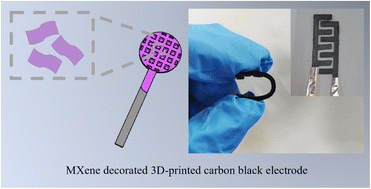
J. Mater. Chem. A, 2023,11, 25422-25428
https://doi.org/10.1039/D3TA04573K
Solar-driven photocatalytic removal of NO over a concrete paving eco-block containing black TiO2
The as-prepared black TiO2-based concrete paving eco-block exhibits outstanding photocatalytic NO removal efficiency without harmful by-products and an enhanced binding force between the photocatalyst and concrete matrix.

J. Mater. Chem. A, 2023,11, 25429-25440
https://doi.org/10.1039/D3TA05763A
A facile strategy to achieve vitrimer-like elastomer composites with lignin as a renewable bio-filler toward excellent reinforcement and recyclability
Vitrimer-like elastomer composites with lignin as a renewable bio-filler, showing effective reinforcement, recyclability and photothermal performance, were prepared.

J. Mater. Chem. A, 2023,11, 25356-25367
https://doi.org/10.1039/D3TA05205B
Reaction mechanism and kinetics of oxygen reduction reaction on the iron–nickel dual atom catalyst
Dual-atom catalysts (DACs) have recently emerged as promising and high-activity catalysts for the oxygen reduction reaction (ORR), a key process in many electrochemical energy conversion devices.

J. Mater. Chem. A, 2023,11, 25410-25421
https://doi.org/10.1039/D3TA05694E
Cu-ATC vs. Cu-BTC: comparing the H2 adsorption mechanism through experiment, molecular simulation, and inelastic neutron scattering studies
A combined experimental, inelastic neutron scattering, and theoretical study revealed that the metal–organic framework Cu-ATC exhibits greater H2 adsorption affinity compared to the well-known Cu-BTC.
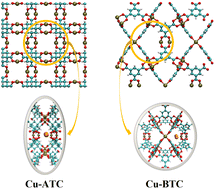
J. Mater. Chem. A, 2023,11, 25386-25398
https://doi.org/10.1039/D3TA04748B
p-State of surface oxygen for mediating the s-band center of a single-atomic Ag catalyst for enhanced catalytic property for the oxygen reduction reaction
The crucial role of the s-band center of single-atomic Ag catalysts on their catalytic selectivity for the ORR is theoretically uncovered.

J. Mater. Chem. A, 2023,11, 25399-25409
https://doi.org/10.1039/D3TA04453J
Ultrafine Co3O4 nanoparticles-engineered binary metal nitride nanorods with interfacial charge redistribution for enhanced water splitting
Herein, an efficient bifunctional electrocatalyst based on binary metal nitride (Zn3N2–Co2N) nanorod arrays decorated with ultrathin Co3O4 nanoparticles is prepared to improve overall water splitting performance.

J. Mater. Chem. A, 2023,11, 25332-25344
https://doi.org/10.1039/D3TA04768G
Tribovoltaic effect promotes highly efficient direct current generator
Currently, extremely high voltage output has been achieved by a direct current triboelectric nanogenerator (DC-TENG) based on semiconductor–semiconductor interfaces.

J. Mater. Chem. A, 2023,11, 25377-25385
https://doi.org/10.1039/D3TA04807A
On-site formation of silver decorated carbon as an anodeless electrode for high-energy density all-solid-state batteries
Anodeless electrode composed of Ag ion complexes and carbon black was fabricated. All-solid-state batteries with anodeless electrodes exhibited improved cyclability, highlighting the usefulness of anodeless electrodes for this emerging technology.

J. Mater. Chem. A, 2023,11, 25275-25282
https://doi.org/10.1039/D3TA05307E
About this collection
This on-going web collection features all the articles published in Journal of Materials Chemistry A in 2023 marked as HOT, as recommended by referees. Congratulations to all the authors whose articles are featured!